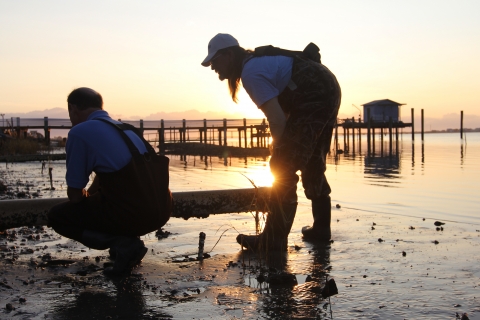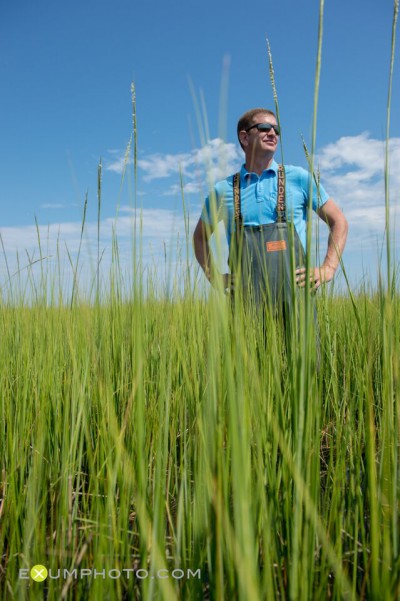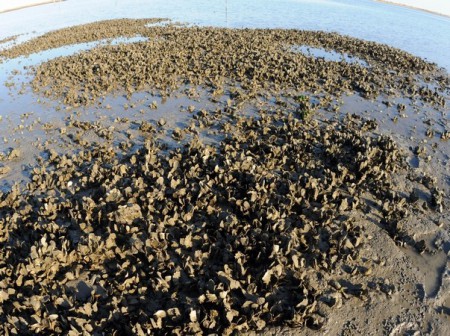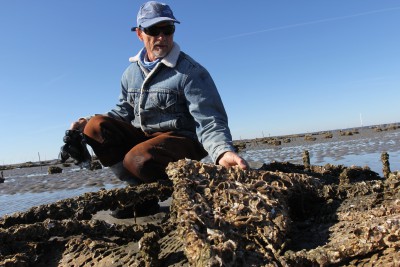Reprinted from Endeavors, a publication of the University of North Carolina-Chapel Hill
MOREHEAD CITY –Crouched down in six inches of mud at dead low tide, a fisherman and a scientist start their work day. With the sun still rising over the Atlantic Beach bridge, the marsh is serene and silent — except for the occasional crack of an oyster shell.
Supporter Spotlight
“Niels! Look at this one! What a beauty!”
With the excitement of a child on Christmas morning, a 55-year-old Carteret County fisherman holds up a large oyster. His name is David Cessna, but everyone calls him Clammerhead. He stares at the oyster, smiling.
“I’ve been struck by lightning three times,” he says casually, in a classic Eastern North Carolina drawl. “I’ve been shot once, stabbed twice, had over a hundred broken bones, two strokes, three heart surgeries and six other surgeries. I’ve got a stainless steel ankle, I’ve been married three times, I’ve got 13 kids and you know what? This right here is the best adventure I’ve ever been on.”
Forging a Partnership

This oyster-growing adventure began where many adventures do — at the edge of Bogue Sound in the University of North Carolina’s Institute of Marine Sciences here in Morehead City. But when institute scientists first approached him about working with them on some research projects, Cessna wasn’t sure how things would go. “Fishermen and scientists haven’t always seen eye-to-eye on this stuff,” he says.
When it comes to figuring out what’s best for the environment and the seafood industry in Morehead City, Cessna says scientists have traditionally taken one side while fishermen take the other. “There was always a big gap in communication,” he says. “A lot of it had to do with fishermen not trusting scientists and scientists not understanding a lot of what the fishermen were doing. So they didn’t really have that much interest in what the fishermen were saying.”
Supporter Spotlight
But the scientists were all ears. “Niels Lindquist and Joel Fodrie were real receptive,” Cessna says. “And that helped open the doorway to realizing the scientists aren’t bad guys.”
Lindquist has a Ph.D. in chemical ecology from the Scripps Institute of Oceanography in San Diego. He spent most of his career working with coral reef sponges — knowledge that translates well for better understanding oyster reefs and creating magic material on which to grow oysters. Cessna, on the other hand, has been working on fishing boats since he was 6 and also has years of experience working in construction. It turns out that knowledge comes in handy for inventing new materials for building oyster reefs, too.
Their partnership has fostered greater respect and understanding between the scientists and fishermen over the past few years, according to Cessna. “This work has opened up a line of communication that has spread to a lot of people on both sides,” he says. “Commercial fishermen and scientists are now working together better than ever before in coming up with solutions to a lot of the problems we face.”
Tackling the Problem

North Carolina’s oyster populations are in trouble. Our coastline produced 1.8 million bushels of oysters in 1902, according to Lindquist. Today, only 5 percent of those oyster populations remain. Environmental changes, loss of habitat, pollution, disease and overharvesting are the major culprits.
A healthy adult oyster filters about 50 gallons of water every day. Fewer oysters mean more nutrient pollution and contaminates in the water, which leads to less viable product for the seafood industry as a whole. Oysters create healthy habitats for animals like blue crabs and finfish — small species that have a commercial value of $62 million annually, according to the N.C. Coastal Federation, a conservation group headquartered just a few miles down N.C. 24 in Ocean. It has been a leader in building oyster reefs.
“Despite a couple decades of restoration efforts, oyster populations have not come back well at all,” Lindquist says.
He and Cessna are not the first people to try to tackle the issue of North Carolina’s depleted oyster populations. Since it takes up to three years for oysters to grow to market size in the wild, many aquaculture set-ups grow oysters modified to have three sets of chromosomes, instead of the natural set of two. Those take anywhere from 14 to 18 months to grow to three inches.
With the extra set of chromosomes, the modified oysters — commonly referred to as triploids — can’t reproduce. All the energy that normally goes into reproduction gets redirected into growth. In North Carolina, triploid oysters typically reach three inches in 18 to 24 months.
The scientist and the fisherman, on the other hand, want to grow market-ready oysters in 12 to 15 months — all naturally.
Building a Neighborhood
A traditional oyster bed sits on a mud flat and spreads far in all directions — a bit like a sprawling suburban neighborhood.
Lindquist and Cessna have built structures that allow their oyster communities to grow up instead of out. In place of suburban sprawl, they’re creating oyster apartment buildings. And just like with skyscrapers in a big city, these structures allow them to pack a larger population into a smaller space.
On a blustery, cold day in early December, Lindquist and Cessna stand on a sandbar in the middle of the Intracoastal Waterway at low tide. There is a hole somewhere in the waders Lindquist is wearing and his boots have filled with cold water. He doesn’t mind. With a big smile plastered to his face, he shows off his playground of oyster habitats. Over here are the “cow pies” — circular disks covered in oysters. Over there are the panels — large, rectangular mats of oysters. One set-up using rods looks like underwater hopscotch. As the tide drops lower, you can see more and more oysters growing in all shapes and sizes, on all kinds of surfaces.
“A lot of people put out substrates with no oysters on them — that substrate can just be oyster shell or various types of rock,” Lindquist says. “Basically you cross your fingers and hope the oysters settle, grow and survive. It’s kind of a crapshoot whether that works or not.”
Creating Magic Material

Cessna holds up one of the long rods that looks like it’s been splattered by mud. “See all those little black specks? Those are baby oysters.”
Oysters reproduce through spawning. After the eggs are fertilized, they become larvae that drift with the currents for a few weeks. Once the larvae are about two to three weeks old, they start searching for a hard substrate. The challenge for Lindquist and Cessna was to develop a material that would be solid enough to attract oyster larvae, but not harm the natural environment. It took some tinkering to get the material and structures just right. They spent the better part of three years perfecting the substrate — a mix of cement and porous natural fabric — before beginning the field phase of the project. “We knew we’d have limited resources and we didn’t want to make any unnecessary mistakes,” Cessna says. Once they got the materials in the water, oyster larvae began attaching to them.
They call it an ephemeral substrate. “Ephemeral” means “lasting for a very short time,” and that’s exactly how this magic material works — unless oysters attach to it. “If the oysters like it, they’ll latch on and grow like crazy,” Cessna says. “If they decide they don’t like it, the substrate just decomposes without harming the environment.”
Growing a Billion Oysters
Spread your arms wide — that’s about the width of one of these panels of oysters. “We can grow about 5,000 oysters on each panel and I can still pick it up myself,” Lindquist says, lifting the sodden panel up out of the water. “So if you think about what a billion oysters would be — that’s 200,000 panels.”
According to Lindquist, 200,000 panels is a manageable number, given the right kind of manufacturing support. “It would take a couple years to reach the target, but we could get there.”
He and Cessna produced 40 panels last summer in a couple hours with just the two of them working in what Lindquist calls “a very low-tech manufacturing facility.”
After hauling their various types of substrates to their oyster neighborhood, oyster larvae from the passing waters settled onto their substrates, creating the dense oyster communities.
“There are a lot of people out there who grow oysters and think we’re crazy,” Lindquist says, chuckling. “But as soon as people see this, they get it.”
Most North Carolinians are familiar with the flat, razor-shaped oysters. But oysters don’t necessarily have to grow that way. “That’s because they don’t have room to expand. What we’re doing is giving them a lot more room to expand,” Cessna says. Their oysters are more round, plump and meaty.
Getting Down to Business

The annual U.S. oyster harvest is currently valued at around $250 million, according to Lindquist. If he and Cessna can scale up their operation, expanding it to other states — and eventually the entire Atlantic Coast — he believes it could “contribute significantly” to the number of oysters grown in the nation and the value of that harvest. Lindquist is currently awaiting approval of the patent he submitted to the U.S. Patent Office.
Meanwhile, Lindquist is keeping close tabs on companies with similar ideas. “I just got an e-mail from a company in New Zealand that’s developing a biodegradable cable tie. I had sent them an email about a year ago asking if we could get a sample. They said, ‘We’re moving towards manufacturing — we just need to get an idea of who would be interested in using this material. Are you interested?’”
Yes, the scientist and the fisherman from Carteret County, North Carolina, are very interested. “That ephemeral nature is dear to us,” Lindquist says. “We could use those cable ties to very quickly tie together a structure and not worry about introducing plastic trash into the environment.”
It’s too early in the game to be estimating potential dollar amounts, but Lindquist is hopeful it will become an industry that generates a lot of revenue, jobs and opportunities for people in different places. “Just the manufacturing of the substrate can become an industry that could employ a lot of people,” he says. “Because it’s ephemeral, you need to come back and get more of it every year. If we grow the business, that makes the demand even higher. That could become a pretty substantial part of the business.”
Working with the Kenan Institute for Private Enterprise, and the Small Business and Technology Development Center of North Carolina, Cessna and Lindquist are exploring the many possible avenues for funding their start-up business.
“We’re looking at all the different options available to us,” Lindquist says. “We can grow new oysters for the consumption market, for building reefs along shorelines, for helping to restore oyster habitat. We just need to understand each market a little better, and see what makes the most sense.”
Putting Something Back
Rebuilding North Carolina’s oyster population is no small task but Cessna and Lindquist have enthusiastically stepped up to the plate. “We can do a lot of good for fishing communities by bringing this technology to different water bodies,” Lindquist says. “We want to work with commercial fishermen to develop a program where everybody benefits from growing oysters — for food markets but also for restoration and living shorelines.”
He and Cessna are already working on developing partnerships with the Division of Marine Fisheries and the Coastal Federation to make this a reality.
When Cessna talks about sustaining coastal fisheries and this oyster work in particular, he compares being a good fisherman to being a good farmer. “You only take what is ready to harvest, you only take it down to a certain level, and when given the opportunity, you put something back,” he says. “This gives me a chance to be involved in the scientific aspect of putting something back for future generations. The way things look to us now — this is a good tool to re-populate the oysters in this area and in a lot of other areas. And that’s something to feel pretty good about.”







